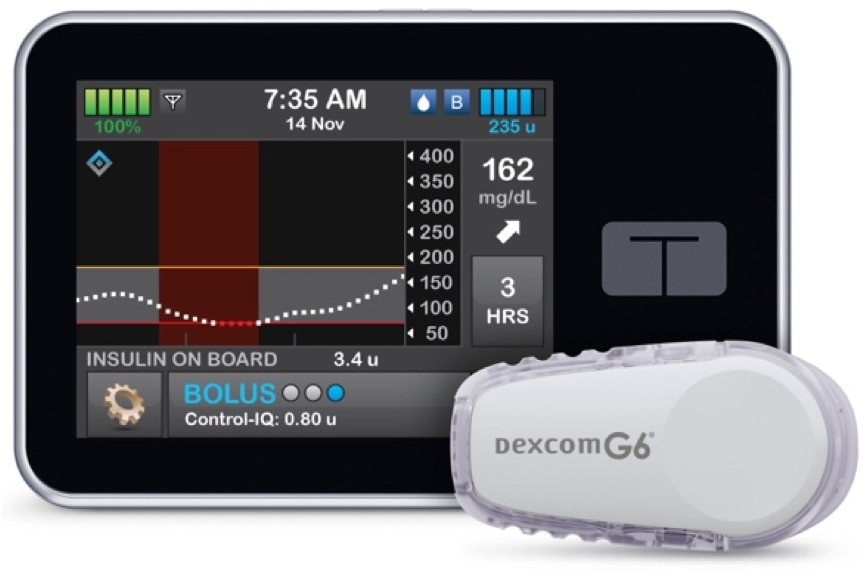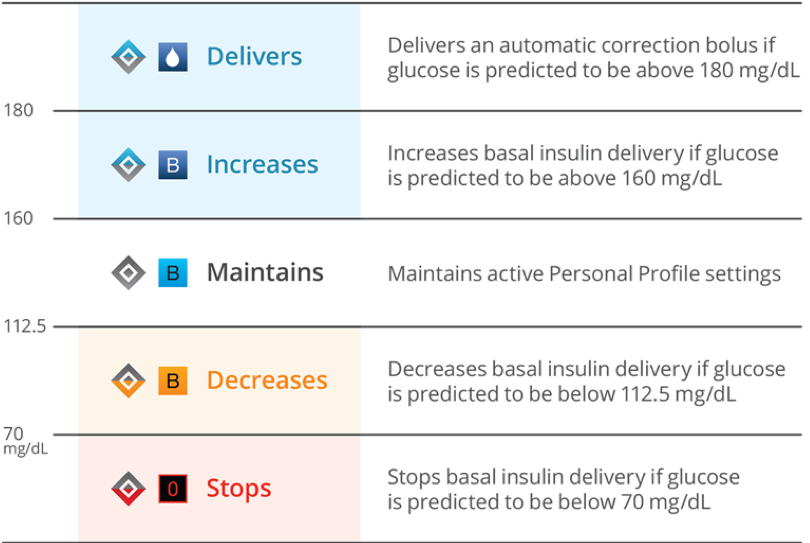Tandem’s Control-IQ Cleared in United States
By Jimmy McDermott
 By Jimmy McDermott and Albert Cai
By Jimmy McDermott and Albert Cai
Control-IQ the first AID system with automatic correction boluses and no fingersticks CGM (Dexcom G6); cleared for those ages 14 and older; launch in January 2020
Editor's note: this piece was updated on 1/16/20 with the launch of Control-IQ
The FDA and Tandem announced that Control-IQ – an automated insulin delivery (AID) system – is cleared in the United States. Control-IQ combines the t:slim X2 insulin pump, the Dexcom G6 CGM, and an algorithm built into the pump that adjusts basal insulin delivery and gives automatic correction boluses.
Tandem officially announced the launch of the hybrid closed loop system in January 2020. New t:slim X2 pumps with Control-IQ are “now shipping” to new customers, while “emails are being sent out in batches” to all current in-warranty t:slim X2 users. For current t:slim X2 users, Control-IQ will be a free software upgrade that can be done at home, but will require a new prescription and completion of online training, similar to the update process when Basal-IQ launched. Tandem’s emails to current users will provide access to an “online portal” where users can request a new prescription and complete their online training – for context, the training for Basal-IQ took about 45-minutes to complete.
Want to see examples of the pump screen? Tandem updated its t:simulator app (App Store; Google Play) and website with Control-IQ. The t:simulator app allows users to look at Control-IQ on a simulated pump screen on their phone. Photos of the screen can also be seen at the bottom of this article.
This clearance was based on results from Tandem’s Control-IQ hybrid closed loop pivotal trial presented at the American Diabetes Association’s (ADA) 79th Scientific Sessions. The trial had 168 participants ages 14-71 and followed them for six months. Comparing the Control-IQ hybrid closed loop vs. the same pump and CGM without the Control-IQ algorithm:
-
Time-in-range was a whopping 2.6 hours per day better with Control-IQ (70% vs. 59%), with most of the benefit from users spending 2.4 fewer hours per day above 180 mg/dl.
-
A1C was 0.3% lower with Control-IQ (7.1% vs. 7.4%).
-
Average blood glucose was 14 mg/dl lower with Control-IQ (156 mg/dl vs. 170 mg/dl).
-
Time below 70 mg/dl was low (less than 2%) in both groups, though Control-IQ did slightly better at reducing time below 70 mg/dl by 13 minutes. That may not sound like much, but it’s six and a half hours a month less time that participants were hypoglycemic.
With Control-IQ, the time-in-range benefits existed for every level of starting A1C – a positive sign that Control-IQ can help those already at a low A1C and those with higher A1C. Remarkably, all 168 participants completed the study, and Control-IQ users spent 92% of the six months with closed loop active. In the study questionnaire, people scored Control-IQ:
-
4.8/5 on desire to continue using
-
4.7/5 on ease of use
-
4.6/5 on usefulness
-
4.5/5 on trust
How does Control-IQ work to keep people in-range?

Control-IQ uses the TypeZero/Dexcom hybrid closed loop algorithm, which still requires all the normal pump settings (basal profile, insulin-to-carb ratio, insulin sensitivity factor). The system aims to keep users between 70-180 mg/dl as much as possible, using a combination of strategies. When the predicted CGM value in 30 minutes is:
-
Above 180 mg/dl, it gives a correction bolus
-
Above 160 mg/dl, it increases the basal insulin rate
-
Between 112.5-160 mg/dl, it maintains the default user settings
-
Below 112.5 mg/dl, it decreases basal insulin
-
Below 70 mg/dl, it turns off basal insulin
Users are still expected to bolus for meals. The automated correction boluses occur when predicted CGM values in 30 minutes are above 180 mg/dl, a maximum of once per hour during the day; Control-IQ will give about 60% of a full correction bolus with a target of 110 mg/dl. These boluses occur on top of the automatic basal rate.
During the day, the system targets a range of 112.5-160 mg/dl. It is more aggressive at night – the goal is to arrive at 112.5-120 mg/dl by the time the user wakes up. Control-IQ also has an “exercise mode” that changes the target to be closer to 140-160 mg/dl in order to prevent any hypoglycemia.
.png)
.png)
.png)







